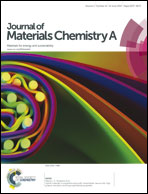Synthesis of ZnO@ZnS–Bi2S3 core–shell nanorod grown on reduced graphene oxide sheets and its enhanced photocatalytic performance
Abstract
ZnO@ZnS–Bi2S3 core–shell nanorods anchored on reduced graphene oxide (RGO) were prepared by combining the hydrothermal treatment and ion exchange technique. The nanocomposites were characterized by scanning electron microscopy (SEM), transmission electron microscopy (TEM), X-ray diffraction, Raman, X-ray photoelectron spectroscopy (XPS), UV-Vis diffusion reflectance spectroscopy, room-temperature photoluminescence spectra (PL), and their photocatalytic performance for H2 evolution under 300 W Xenon lamp irradiation was evaluated. The as-prepared RGO/ZnO@ZnS–Bi2S3 core–shell nanorods display a wide and strong photo absorption in the visible region and exhibit a higher photocatalytic activity for H2 evolution from the glycerol water mixtures as compared with the RGO/ZnO nanorods and RGO/ZnO@ZnS core–shell nanorods. Under the optimal Bi2S3/ZnS molar ratio in the shell layer, the highest photocatalytic hydrogen production rate of 310 μmol h−1 g−1 is observed. The highly improved performance of the composites can be ascribed to the increased light absorption and efficient charge separation.


 Please wait while we load your content...
Please wait while we load your content...